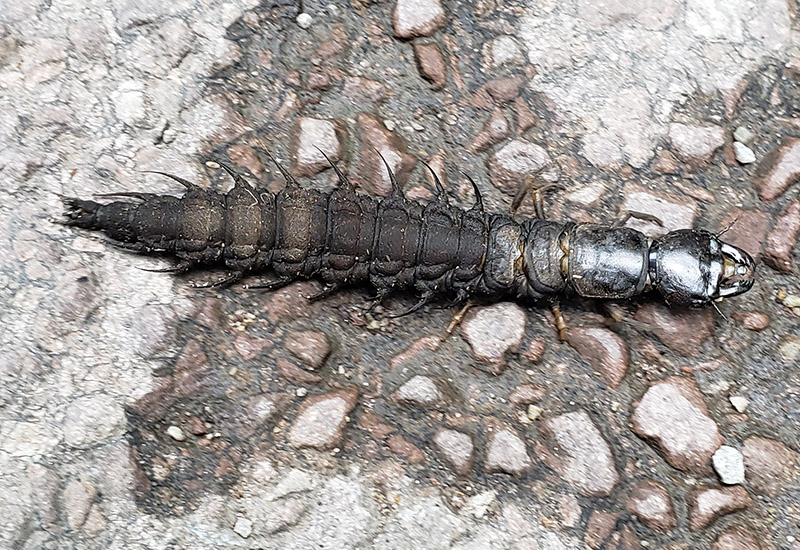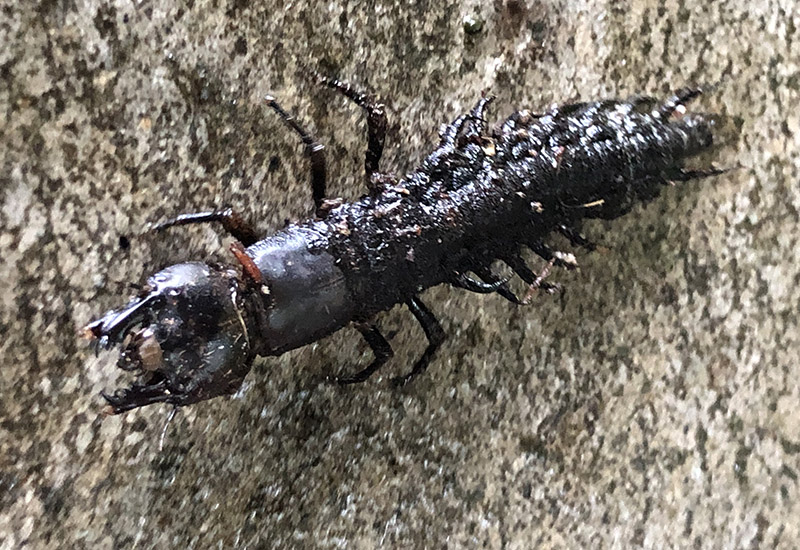This article is a complete primer on the dobsonfly larvae, otherwise known as hellgrammites.
The dobsonfly is an interesting species, to say the least, with its large and somewhat scary appearance.
However, it’s their larvae we’ll be talking about in this article—the hellgrammites.
Easy to mistake for a centipede, the hellgrammites are unlike most insect larvae you’d find out there. Despite their appearance, dobsonfly larvae are relatively harmless.
If you’re curious to learn more about these aquatic larvae, let’s dive right into this article right away.

What are Dobsonfly Larvae?
The hellgrammites are the larvae of the dobsonfly, one of the largest insect species in the world.
Unlike what their name indicates, dobsonflies aren’t really flies. Like alderflies and fishflies, these insects belong to the order Megaloptera.
The larvae are aquatic, with flattened and elongated bodies.
Such a structure, together with the eight pairs of leglike appendages with hairy gill tufts, gives them a resemblance to centipedes.
Hellgrammites are black, brown, or dark tan in color and grow up to a length of four inches.
What do Dobsonfly Larvae Eat?
Dobsonfly larvae are carnivorous and prey on various aquatic creatures, including other insects, worms, arthropods, and even fish.
They aren’t very picky when it comes to food. Being generalist predators, hellgrammites eat whatever is available to them at the moment.
However, the size of the prey matters—it goes up along with that of the larvae. Larger hellgrammites wouldn’t usually eat smaller prey.
Dobsonfly larvae are excellent predators, thanks to the several structural adaptations that allow them to sense, chase, and hunt their prey.

Where Do Hellgrammites Live?
Hellgrammites are aquatic insects commonly found in rivers, streams, and creaks. They prefer shallow and fast-flowing waters and often hide under rocks and logs.
In this regard, you should note that dobsonfly larvae live only in clean and unpolluted water bodies.
The water should also have a neutral pH level; any deviation can cause them to leave the body of water in search of a more suitable habitat.
Life Cycle of A Hellgrammite
Like most insects, hellgrammites go through four life cycle stages: eggs, larvae, pupae, and adult dobsonflies.
However, their life cycle is quite interesting if you consider the duration of different stages.
Eggs
Each female dobsonfly lays up to three egg masses that look similar to bird droppings, each containing 1000 eggs on average.
The eggs hatch in two to three days.
Dobsonfly eggs are laid in one to five layers, usually near the surface of the water.
The females cleverly hide them among leaves, branches, and other kinds of shade to keep them safe from predators.
Larvae
The larvae are, of course, the very hellgrammites we are talking about. They crawl into the water as soon as they are born and remain completely aquatic during this stage.
Among all the insects in the Corydalidae family, dobsonflies have one of the longest larval stages.
Hellgrammites molt 10 to 12 times and remain as larvae for anywhere from one to five years. The speed of their development depends on their habitat.
Hellgrammites develop several distinct physical features during this stage, including prominent pincers and hook-like appendages to grab onto surfaces.
Interestingly, dobsonfly larvae can swim backward – not many insects can do that.

Pupae
Once the larvae are fully grown and have completed all the molting stages, it’s time for them to pupate. This is when they leave the water body and move inland.
The fully-developed hellgrammites now settle down in a wet and cool place near the water body, usually creating a hollow chamber under tree bark and in crevices.
The pupal stage can last two to four weeks, after which the adults emerge.
Adults
Adult dobsonflies are even larger than hellgrammites, growing up to a length of 5 inches. They have glassy wings with conspicuous veins and are capable of fluttery flight.
Despite their total lifespan being so long, dobsonflies live a very short time as adults. The males have only a few days to live, while the female dobsonflies live for around 10 days.
Do They Bite?
Hellgrammites have powerful and heavily sclerotized mandibles that allow them to deliver a painful bite. When hunting, they use sharp pincers to kill the prey.
In adult dobsonflies, the mandibles of males are unsuitable for biting.
Only the females can bite hard enough to hurt you. The adult males use their tusks simply to grasp the females during mating.
Are They Poisonous/Venomous?
Despite their scary looks, hellgrammites do not carry any poison or venom. Besides its painful bite, the aquatic larva is rather harmless.
The same applies to adult dobsonflies too, both males and females.
Are They Harmful or Beneficial to Humans?
While you might want these scary-looking insects out of your pond, hellgrammites are beneficial to the environment.
Not only do they play a major role in the aquatic food chain, but they also control the population of other insect species by hunting them.
These include black flies too—a pest notorious for its nasty bite.
Besides, hellgrammites are also used as fish bait because they are prey for larger species of fish.
Dobsonfly Larvae Structural Adaptations
Remember what I mentioned earlier about dobsonfly larvae having several structural adaptations? You may check them out in greater detail if interested, but here’s a quick overview.
Strong mouthparts
As I explained, hellgrammites need their strong pincers to rip apart their prey. They’re one of the most effective predators in their habitat.
Terminal hooks
Dobsonfly larvae live in fast-flowing waters, which means they’re always at risk of getting washed away by the water current. The hooked appendages at their rear end allow them to avoid this by latching onto rocks or other surfaces.
Sensory abilities
Locating prey in fast-flowing waters can be a difficult task. However, dobsonfly larvae have excellent sensory abilities. In addition to eyesight, they can also locate their prey via touch and chemical sensing.
What Are Dobsonfly Larvae Attracted To?
Dobsonfly larvae are attracted to clean water bodies with balanced pH levels. They also prefer water bodies with plenty of fish or other prey to hunt.
Adult dobsonflies are attracted to electric lights, which is how they often end up in homes.
How to Get Rid of Dobsonfly Larvae
Having hellgrammites swim around in your pool can be a problem—you certainly don’t want to get bitten by them while taking a swim.
The easiest solution would be to fish them out with a net and remove them.
You may also add some more chlorine to the water; it will disturb the pH level and make the water unsuitable for dobsonfly larvae.
As for dobsonfly larvae infesting a pond, it’s best to just leave them be.
Treating the water with pesticides would affect all other life in the pond, including the fish. Besides, hellgrammites are an important part of the aquatic ecosystem.
Interesting Facts About Dobsonfly Larvae
Before we wrap up this topic, here are some interesting facts about dobsonfly larvae that you might like:
- Dobsonfly larvae can swim both forward and backward by undulating their bodies. This helps them navigate the fast-flowing waters and catch their prey.
- The segmented abdomen of a hellgrammite has eight pairs of legs, each with a tuft of a cottony or hairy gill at its tip.
- Though they might look like something out of a horror movie, dobsonfly larvae are extremely beneficial insects. They keep water bodies free of various harmful pests.
- Most dobsonfly larvae in North America belong to the same species, the Eastern Dobsonfly. However, there are 30 different species of dobsonflies in the world.
Frequently Asked Questions
What is a Dobsonfly larva?
Dobsonfly larvae are also known as hellgrammites and are the larvae of one of the largest insect species in the world. They are not flies but rather belong to the order Megaloptera.
These aquatic larvae have elongated bodies and leg-like appendages with hairy gill tufts, giving them a centipede-like appearance.
They are black, brown, or dark tan in color and can grow up to four inches in length.
Are Dobsonflies rare?
Yes, adult dobsonflies are rare. Throughout most of their lives, they remain in their larval form, known as hellgrammites.
Hellgrammites go through four life cycle stages: eggs, larvae, pupae, and adult dobsonflies.
The eggs hatch in two to three days, and the larvae remain completely aquatic during this stage, molting 10 to 12 times and remaining as larvae for one to five years.
Once the larvae are fully grown, they pupate and settle in a wet, cool place near the water body. The pupal stage lasts two to four weeks, after which the adults emerge.
Adult dobsonflies are even larger than hellgrammites and have glassy wings with conspicuous veins. Despite their long lifespan, dobsonflies live a very short time as adults.
What do Dobsonfly larvae eat?
Dobsonfly larvae are carnivorous and eat various aquatic creatures, including insects, worms, arthropods, and even fish.
They are generalist predators and eat whatever is available to them, but the size of the prey matters as it goes up along with the size of the larvae.
These larvae have several structural adaptations that allow them to sense, chase, and hunt their prey.
What are the advantages of Dobsonfly?
Dobsonfly larvae act as predators in the food web, controlling populations of other aquatic invertebrates.
They are prey for other invertebrates, fish, and some terrestrial vertebrates. Predatory fish are their main natural enemy, and their larvae are used as bait by fishermen.
The aquatic larval stage is an indicator of excellent stream health in bio-monitoring surveys, found in unpolluted water.
Wrapping up
As you can see, dobsonfly larvae are a rather unique species of aquatic insects. Despite the large number of eggs laid by the females, these insects are hard to come by.
This is because the adults don’t live long while the larvae stay underwater in fast-flowing parts of rivers and streams most of the time.
If you love studying different insect species, though, I do hope you’d be able to look at a dobsonfly larva up close.
Reader Emails
Due to their scary appearance and their long life spans, hellgrammites have been a constant source of questions from our readers.
Please go through some of these emails and the questions that have been asked about these larvae.
The post Dobsonfly Larvae: All You Need To Know appeared first on What's That Bug?.
No comments:
Post a Comment